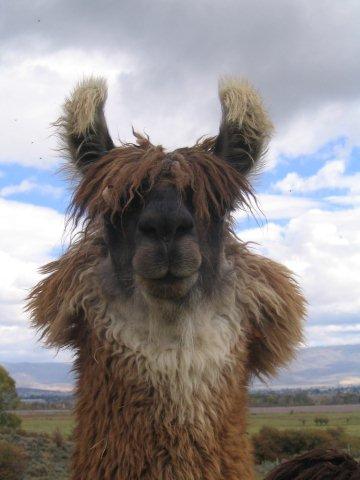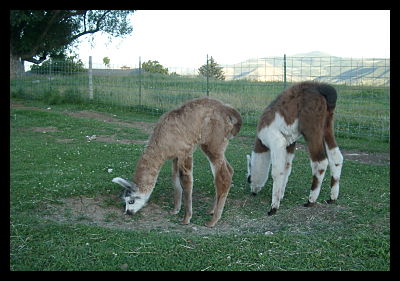
Camchatka Says Hello
Background:
Llamas are members of the camel (camelid) family, which includes llamas, alpacas, vicunas, and guanacos. Their scientific name is Lama glama (Linneas, 1785). They are descended from the wild Andean guanaco and were domesticated between 7000 and 8000 years ago. The name lama is a Quechua Indian word. When spelled with one L the term lama refers to all four South American camelids.
What Llamas Are Used For:
Pack animals, companion animals, cart animals, parade animals; guard animals (sheep, goat, or turkey); garden manure producers; fiber producers (for knitting, crocheting, spinning, weaving, and other craft uses); pets; hiking companions; therapy animals; golf caddies; lawn mowers; FFA or 4H project animals; and meat animals.
Physical Facts:
Llamas live from 15-25 years and can weigh from 250 to 500 plus pounds. They stand from 40 to 48 inches at the withers and from 5 to over 6 feet at the head. They come in colors of white, grey, red, brown, and black, and can be solid, spotted, or marked with various patterns. Llamas are described as light, medium,or heavy wool, depending on the amount of wool on the head, neck, and legs. Their fiber is hollow (medullated) like human hair, contains no lanolin, and is extremely warm and light.
Personality and Communication:
Llamas are intelligent, extremely curious, and easy to train. They are highly social animals, and need the companionship of others to feel comfortable. For this reason they should always be kept in groups of two or more. They are stoics, and do not display pain easily. Llamas are generally very quiet, but communicate with a series of body, ear and tail postures, a shrill alarm call and a variety of humming noises. Llamas do spit, but usually only at each other. Spitting is normally used among llamas to establish pecking order at meal times, defend personal space, ward off an annoying threat, divert an unwelcome suitor, or discipline a baby. However a llama that feels threatened by a specific human behavior may spit at that particular behavior.
Care and Feeding:
Llamas are a modified ruminant with a three-chambered stomach, and chew their cud like cattle and sheep. They normally will consume 3-5 pounds of hay per day. A good one-acre pasture can support 2-4 adults. Access to fresh clean water and a good free feed mineral supplement is also needed.
Pasture Management:
Llamas are among the easiest of the large domesticated mammals to keep. Their pasture can be fenced with woven wire, wire cattle panels, wooden rails, or electric fencing. Barbed wire is not recommended. Either a three-sided shelter or enclosed barn should be provided. The manure of llamas resembles large deer pellets, and is deposited in communal dung heaps. Their manure is not hot, and is an excellent soil additive for gardens. Llamas are generally very clean, and even large herds do not create appreciable odor problems.
Health:
Llamas are generally healthy, hardy, and remarkably disease free. They should be dewormed regularly, and vaccinated annually against enterotoxemia, tetanus, leptospirosis, and various types of internal and external parasites. They are very sure-footed; instead of hooves, they have two-toed feet with two curved nails and a leathery pad on the bottom. Toenails should be trimmed 2-3 times a year. Males develop three pairs of extremely sharp hooked fighting teeth, with should be removed to prevent injury to other animals. Llamas take about two years to grow a full coat, and regular shearing should be done to combat heat stress as well as provide a source of fiber for knitting, spinning, weaving, crocheting, or other craft projects. During periods of severe weather old or weaker animals and very young crias may benefit from a fitted blanket.
Reproduction:
Llamas are induced ovulators. They do not have a heat cycle, and can be bred at any time of the year. For this reason, intact males should be pastured separately from females. Depending on size and development, llama females can be safely bred at 3-4 years of age. Males may be fertile at 9-12 months, but do not become dependable breeders until 3-4 years of age. The average llama gestation period is 350-365 days. A single baby (cria) is normally delivered without assistance, although a dystocia (difficult birth) can occur. Twins are very rare. Newborn llamas weigh between 20 and 35 pounds. Unlike other mammals, llama mothers do not lick their offspring or eat the afterbirth. Crias are normally up and nursing within 90 minutes, and are weaned at 6 months.
Adapted from the ILR Educational Brochure #3, Facts for New Llama Owners, 2004.
